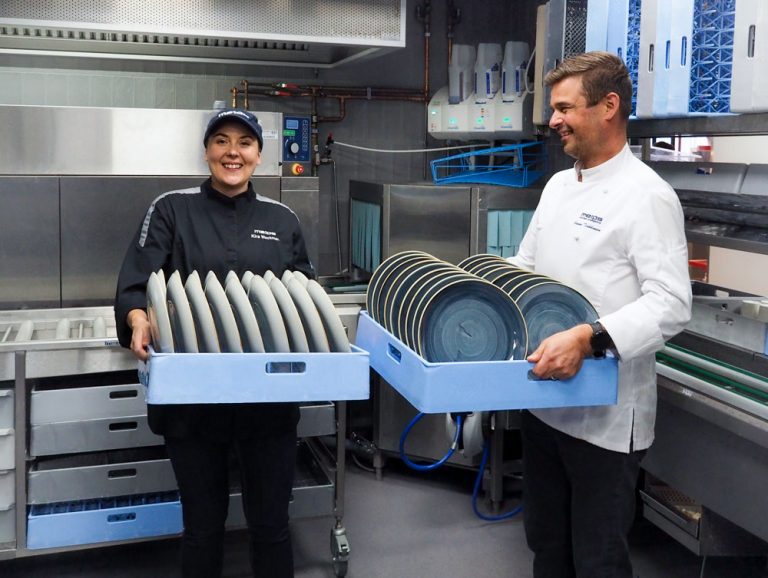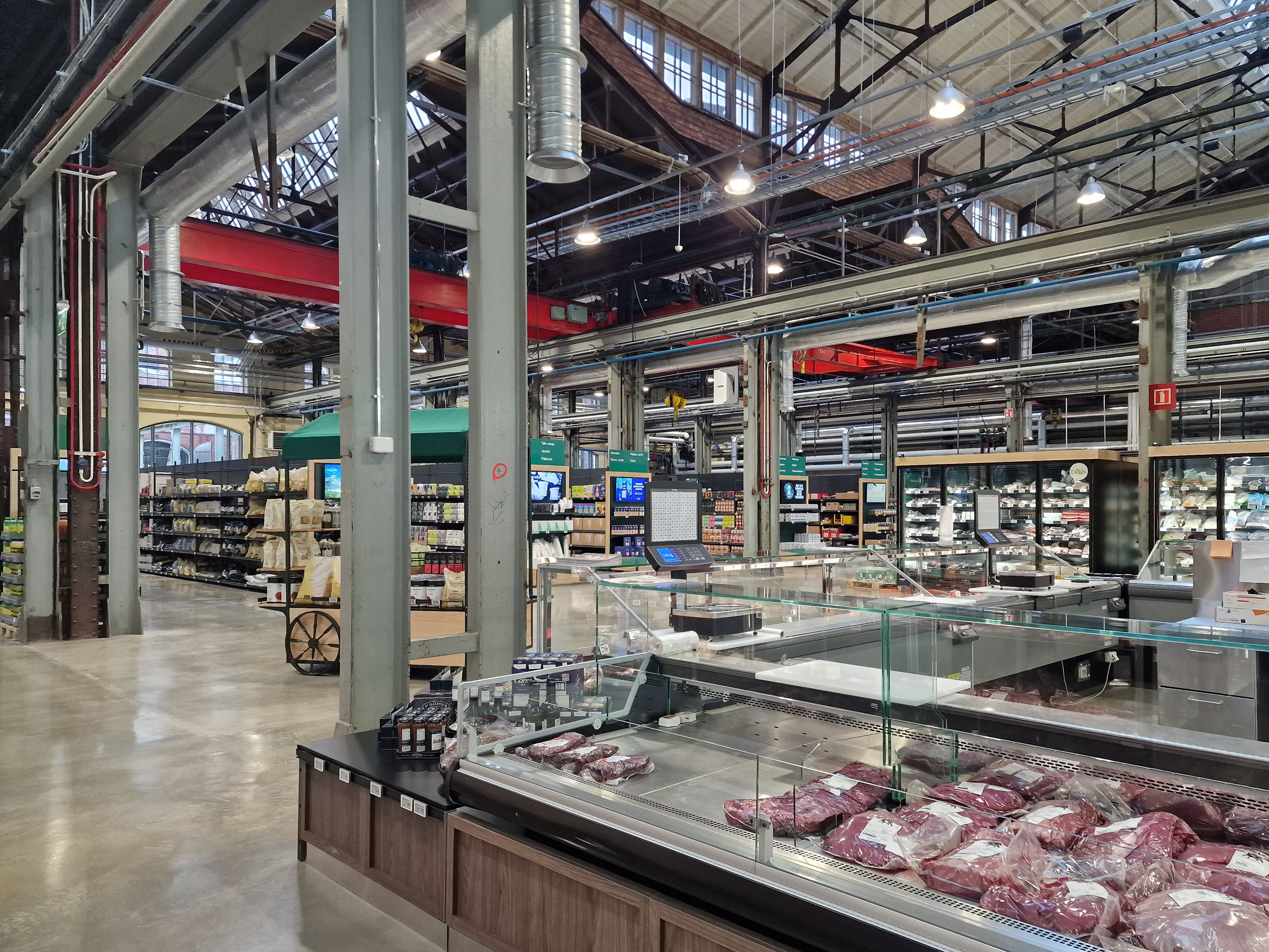The ergonomics of a hood dishwasher are shaped by workstation thinking - Metos FI
The ergonomics of a hood dishwasher are shaped by workstation thinking

With high-quality professional kitchen design, a functional dishwashing station can be built even in a small space. Dishwashing is one of the most labor-intensive tasks in the kitchen, so by improving the ergonomics of hood dishwashers, tangible results can be achieved quickly.
Hood dishwashers have maintained their position as the most popular type of dishwasher in professional kitchens for decades. "Put the basket in, lower the hood and start the washing program" is a simple process, but in terms of work ergonomics, there is much more to consider before the basket of dishes is clean and ready for use again.
Although the technology and features of hood dishwashers have developed enormously, they are not quite as ergonomic as the conveyor dishwashers designed for large volumes. Based on capacity calculations, the hood dishwasher is just the right solution for many kitchens. Sometimes it also replaces a conveyor dishwasher when there is no space for a bigger system in the dishwashing area. It's all about balancing investments, floor space and labor costs.
A compact hood dishwasher allows flexible design
The budget and volume determine the type of dishwasher, but fairly often some ideas are literally blocked by walls. Especially in old properties, the dishwashing area must fit in the available space, and there is absolutely zero room for expansion outwards. In this case, the importance of the worktops, shelves and carts that come with the hood dishwasher is emphasized. A small amount of stuff, but designed very carefully, Janne Tirkkonen from Metos emphasizes.
– Dishes must not pile up waiting to go into the dishwasher. For this reason, especially the furniture on the input side and pre-washing as a process should be planned very thoroughly. A good-sized pre-wash table, an ergonomic pre-wash shower and a big enough sink with an easy-to-empty strainer. In addition, the dishwashing baskets must be easily accessible. Depending on the layout, either a trolley, a wall shelf or space for the baskets under the table could work.
A functional dishwashing area is built from compatible parts
Janne Tirkkonen reminds us that washing dishes is not a job where you turn your brain off and "just wash it". By thinking things through, everyone can participate in the development of the process and thus make the work environment even more pleasant. A single factor that improves ergonomics can be as simple as the size, and location of the biowaste container and how often it is emptied. A 60 liter container is difficult to empty if it is full to the brim.
- Especially when replacing a dishwasher, it is good to review the work that is done in the dishwashing area and what that requires. Remove extra baskets and other less frequently needed articles that take space. Often, one good drawer is enough for the necessary cloths, scrapers and other accessories. It's much better than cucumber jars or mustard buckets on the tables, where the items are scattered and half of them are never needed.
Janne Tirkkonen recommends holding a mini design meeting whenever one of the kitchen's key appliances is replaced. The new products contain a lot of automation that speeds up work, improves working conditions and helps with quality assurance. The features of the best products in the selection include heat recovery, automatic start with basket recognition, automatic hood lifting, and systems that monitor the duration and temperature of the final rinse. The benefits are multiplied as the volume increases. A separate pre-washer is also available for hood machines, which saves water and frees up working time for other tasks.
Different dishes, different lead times
In smaller kitchens, the hood dishwasher is also used as a pot washer. Washing GN containers with burnt food in them is a process that often requires time and space. Janne Tirkkonen recommends thinking of dishwashing as a never-ending loop, where the dishwasher is only one part of the whole.
– Regular soaking of GN pans in large sinks is not really the way things are done these days. Everything starts with the cooking methods. When the right temperatures and humidity control are used, even GN containers are easier to clean. The worst situation is when the dirt sticks and the pans are scratched with hard scrapers. Once the surface is sufficiently scratched, the dirt sticks to it even more.
Another detail to consider on the input side of the dishwasher is the washing of cutlery. Cutlery often goes from soaking to the dishwashing basket, where it is washed for the first time. The second wash is done using cutlery holders, where the cutlery is sorted vertically. This way the cutlery is returned to the customers clean and with as few touches as possible.
The dishwashing area must also have clear instructions on what can be washed in the machine. The grease filters of ventilation hoods may fit conveniently in a hood dishwasher, but washing them in the dishwasher does not necessarily save working time. Once the filters are shiny, the dishwasher is often in need of cleaning. Grease filters can be washed effectively with, for example, a steam cleaner.
Lifting and carrying are heavy work
Metos trainer Kira Weckman has looked at dishwashing areas from many different perspectives. Her current position also includes training people to use shiny new dishwashers and dishwashing areas. As a catering entrepreneur and cook, she has also been washing dishes herself and in the role of a supervisor, orienting new employees to the tasks of the dishwashing area. According to her, you can recognize a well-functioning dishwashing area by the fact that all lifting and carrying has been reduced to a minimum.
– Enough space for clean dishes being unloaded from the dishwasher, so you don't have to move things back and forth and empty each basket immediately after washing. There isn't always room for a long unloading table, in which case basket trolleys and plate trolleys are worth their weight in gold. With the trolleys, the dishes can also be conveniently transported to storage or the line system.
Compatibility can sometimes depend on half an inch
Kira Weckman also emphasizes the importance of pre-washing. It is a time-consuming task that requires space. Good sinks, waste containers close at hand and a pre-wash shower at a suitable height are important tools. Insufficient pre-washing affects the other stages of the process. Washing the dishes twice or having to change the machine's washing water more often than usual will quickly eat away the benefits achieved by skipping steps.
– In terms of ergonomics and efficiency, it is important to ensure that the parts of the system work together. A few times, I have trained employees in a dishwashing area where a new hood machine has been purchased in a hurry to replace the old one that was broken, but the pre-wash and unloading tables are from the old dishwasher. When there is a threshold of one centimeter at both ends, it really starts to hinder the work. The unnecessary movement is repeated even hundreds of times during a work shift, in which case a small issue becomes a big problem.
Kira Weckman also recommends looking at the basket selection when replacing the dishwasher. Having enough baskets of the right size reduces the need to move items and helps keep dishes intact. The 500 x 500 standard baskets do work with both new and old dishwashers, but even baskets have a life cycle. A basket that has lost its shape can easily cause problems in the process.
– A few times there has been a situation where the design of the handle of the old basket has been such that the machine's automation does not recognize the basket inside and the hood does not lower.
Automation reduces heavy and repetitive routine movements
In most kitchens, dishwashing has a higher turnover of staff than other positions, so orientation and instructions are necessary. Hood dishwashers are simple to use, so a quick guide with clear pictorial symbols often provides sufficient written instructions. In many kitchens, it can be found on the wall next to the hood dishwasher.
– The new Metos WD hood dishwashers have an automatic rinsing program, so daily cleaning is very fast. Using a 20-second program, the machine cleans itself well. Combined with the basic cleaning done once a week, it is a very efficien tsystem. A few kitchens have had to unlearn old ways of working, when the new dishwasher has been easier to clean than the old one. Sometimes old dishwashers have required really strong detergents every day to keep them clean, says Kira Weckman.
And what would be the equipment in the trainer's own kitchen that you would definitely want for the hood machine?
– In all kitchen work, I prefer to use automation to handle heavy and repetitive work steps – routines that can be left to a machine without any problems. I would definitely add an automatic hood lifter to the hood dishwasher.






